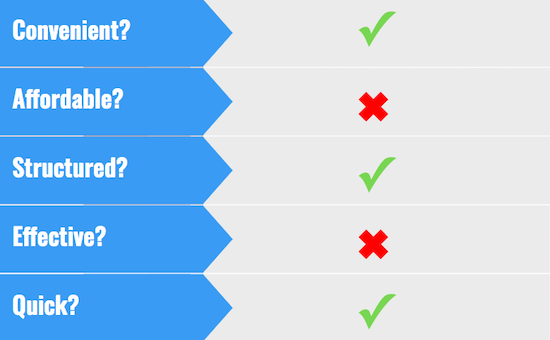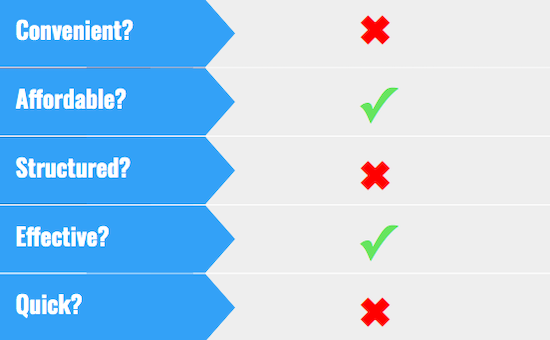
We understand that searching for the right treatment to overcome opioid addiction can be an overwhelming and difficult process. With so many different treatment options, it’s easy to feel alone or confused. We have found that there are some key factors that people tend to prioritize when selecting their treatment option:
- Convenience: How easy is it to fit this type of treatment into your schedule? How much time and effort does it require from you?
- Affordability: How much will this treatment cost? Note: we have chosen to compare self pay rates - you may be able to use your insurance to reduce the price of most treatment options.
- Structure: Is there a set schedule you must follow to receive this treatment? How high is the level of care provided?
- Effectiveness: How well does this treatment work? Is there a high chance of relapse upon completing treatment?
- Length of treatment: How long will you be in treatment for?
The Best Options for Opioid Addiction Treatment in Modesto
1. Telehealth

Telehealth is the newest form of opioid addiction treatment. Technology is utilized to enhance accessibility to Medication Assisted Treatment (MAT). MAT involves the use of medication as well as counseling or behavioral health services to treat addiction. While the first appointment is required to be in person, your follow up visits are done through video or phone calls. Hence, you only have to visit the doctor’s office one time. You may find that this leads to reduced treatment fees as well as lower transportation costs. This might not be suitable for someone who requires a higher level of care for any reason.
Telehealth providers tend to prescribe buprenorphine medications, such as Suboxone, since they can be dispensed at a pharmacy and taken home by the patient. Suboxone is a safe and effective medication. It has a ceiling effect, meaning that you will not feel any greater effect from the medication once you have taken your dose. It also curbs cravings and prevents the feeling of fogginess you might get from other medications. Additionally, it contains Naloxone which blocks the effect of any other opioids you might take. These qualities help prevent the misuse of the medication and reduce the risk of relapse. When you start Suboxone, you will first go through a short period of withdrawal (~12-24 hours) before starting the medication. With a Telehealth treatment plan, this induction can be done in the comfort of your own home. This would not be a fit for someone who requires a supervised induction for any reason. You will also have the option to taper off of Suboxone with the help of your care team.
Think Telehealth might be a good fit for you?
We may be able to help! Get started by speaking with one of our health coaches today: (844) 943-2514. Learn more at https://www.bicyclehealth.com.
2. Inpatient Rehab

Inpatient treatment, also known as residential treatment, involves living in a treatment center for a prolonged period of time. The length of your stay would be determined by yourself and your care team, but tends to range from 30-90 days. Since treatment costs also include room and board, this tends to be an expensive form of treatment. You may also need to take time off work or arrange for childcare while you are away. During your stay, you will have 24/7 care and support. This results in a very high level of care. You will detox from opioids under the supervision of your care team, then you might spend the rest of your stay working on building the tools you need to prevent relapse. You will have a set schedule that you must adhere to each day. Some people find this leads to a higher level of accountability, yet others find this to be frustrating. While in the facility, you may not be able to communicate with friends and family members - this can help decrease distraction and reduce exposure to triggers, however some people might find they are lacking familiar support. Since you will be living in a facility with others, you might find that you can reach for support from your peers who are going through treatment as well.
3. Rapid Detox

A rapid detox involves going under general anesthesia and flushing the opiates from your brain receptors through the use of Naltrexone, which will be injected by your physician. This process tends to take around 4-6 hours. Then, you typically will remain under supervision in the clinic for 24 hours. Since you are under anesthesia for this treatment, you will likely not feel the effects of withdrawal. There is a lot of controversy surrounding rapid detox - it has many risks and comes with a higher risk of relapse than most other treatment options. Additionally, most insurance companies do not cover rapid detox treatment. It tends to be quite expensive out of pocket.
4. Outpatient Methadone Treatment

Outpatient Methadone treatment involves frequently attending a clinic to receive a Methadone prescription. Methadone is a medication used in Medication Assisted Treatment to reduce cravings and withdrawal symptoms. It is taken once a day under the supervision of a physician. This means that you will have to attend the clinic daily in order to receive the medication. Aside from consuming a lot of your time, some people find attending a clinic to be triggering. After a prolonged period of stability, you may be able to take home a few day’s supply of the medication to self administer, but there is no guarantee. Treatment tends to last at least a year, but typically longer. Treatment would end with a supervised, gradual taper off the medication. Methadone is also quite addictive itself, which is something to keep in mind. It is stronger than Suboxone, as it is a full opioid agonist, meaning it fully activates opioid receptors in the brain to full effect. This means that it might be a good option for someone who has been using opioids at a high dose for a long period of time, since it won’t be as drastic a shock to the system. Methadone treatment tends to be covered by insurance, but can cost around $100/week without insurance coverage.
5. Outpatient Suboxone Treatment

Another outpatient option is a Suboxone Clinic. This type of treatment requires that you frequently attend a clinic to obtain Suboxone. Like Methadone, Suboxone is utilized in Medication Assisted Treatment to curb cravings and withdrawal symptoms. It is a partial agonist, meaning the opioid receptors in your brain will not be activated to the fullest effect. It has a ceiling effect, meaning that you will not feel any greater effect from the medication once you have taken your dose. Additionally, it contains Naloxone which blocks the effect of any other opioids you might take. These qualities help prevent the misuse of the medication and reduce the risk of relapse. You will start by attending the clinic at least once a week in order to receive treatment. While this is less time consuming than Methadone treatment, it still is a sizeable time commitment. As treatment progresses, you may receive longer prescriptions and be required to attend the clinic less frequently. There are, however, no guarantees: it would be up to the discretion of your physician. Suboxone treatment tends to be covered by insurance plans. Without insurance coverage, you can expect expenses to run around $100/week. Typically, treatment lasts for at least 6 months, but tends to be longer. It would end with a supervised, gradual taper off the medication.
So … what’s the best treatment option for Opioid Addiction?
As it turns out, there isn’t just one best option. What works for one might not work for another. It might be worth calling a few of the treatment providers listed here to learn more about what they have to offer. Ask them how much the treatment costs, what the risks are and how long the treatment would take. With a little bit of effort, you will soon be on your way reclaiming your life and breaking free from Opioid Addiction.
We hope this guide has helped! If you have any suggestions for us, please send us an email at info@bicyclehealth.com. We look forward to hearing from you!
Modesto Arch image by Amy Vickery under a Creative Commons Attribution 2.0 Generic license.





.webp)